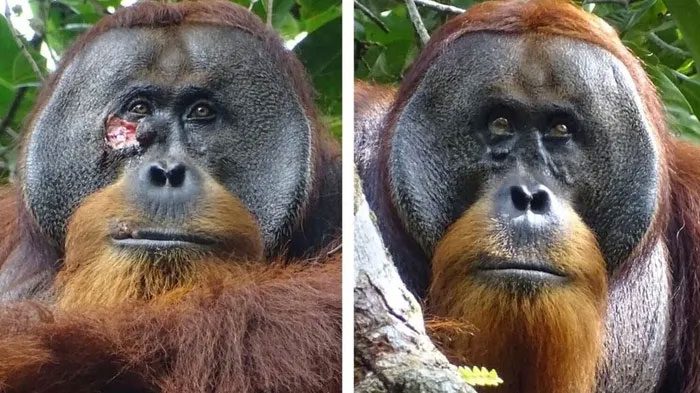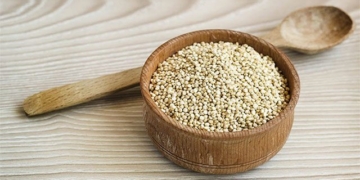Scientists have observed a Sumatran orangutan applying herbal remedies to a wound on its face, seemingly healing the injury. This is the first time this behavior has been documented in wild animals.
Previously, primates were seen either consuming plants or rubbing them on their bodies, a behavior that scientists speculated was aimed at warding off illness or discomfort.
However, the orangutan’s behavior was noted by researchers in Indonesia in 2022 and reported in the journal Nature Scientific Reports on May 2, marking the first time a wild animal has been found using plants with healing properties for wounds.

Before and after images showing the healed wound on a Sumatran orangutan’s face. (Source: AP)
While monitoring a male orangutan named “Rakus” in Gunung Leuser National Park in Aceh province, Indonesia, researchers discovered an open wound on the animal’s face.
Three days later, they observed Rakus chewing on the leaves of the yellow vine (scientific name: Fibraurea tinctoria), known for its medicinal properties and long used in local traditional medicine.
Research conducted by Indonesian and German scientists revealed that the orangutan “began chewing the leaves without swallowing and used its fingers to apply the leaf juice directly from its mouth onto the wound on its face.”
As flies began to swarm the wound, Rakus “covered the entire wound with the leaf pulp until the exposed flesh was completely covered by the green leaves.”
The following day, Rakus was seen consuming the aforementioned vine leaves again, and a week later, its wound began to heal, eventually closing completely without signs of infection.
The study describes this behavior as “the first systematically recorded case of wild animals actively treating wounds with a plant known to contain bioactive compounds.”
The researchers stated that while it cannot be confirmed that this behavior was intentional, the repeated application of water and leaves exclusively to the wound suggests Rakus was attempting to treat its injury.
The researchers also found Rakus chewing the stems and leaves of a plant known as Akar Kuning – a species with anti-inflammatory and antibacterial properties, commonly used by locals to treat malaria and diabetes – applying it to the open wound on its face. Within a month, Rakus’s wound had fully healed.
They speculate that the orangutan may have accidentally discovered this treatment method, perhaps by chewing on the leaves first and then realizing the leaf juice had pain-relieving effects when it unintentionally touched the wound.
Orangutans can learn skills from their peers through observation, but scientists noted that they had not recorded such wound treatment behavior in 21 years and 28,000 hours of observation in Gunung Leuser National Park.
In a recent study, botanists documented the types of plants that gorillas commonly use for food in Moukalaba-Doudou National Park in Gabon.
They identified four plant species that could provide health benefits based on interviews with local healers, including the Fromager tree (Ceiba pentandra), giant golden mulberry (Myrianthus arboreus), African teak (Milicia excelsa), and fig tree (Ficus).

The Fromager tree (Ceiba pentandra) is used by local healers in Gabon for medicinal purposes. (Source: Getty Images)
Local residents report that they often use the bark of these trees to treat various ailments, from stomach issues to infertility.
According to researchers, these plants contain compounds with healing properties such as phenols and flavonoids, which are strong antioxidants and reduce inflammation. All four species exhibited antibacterial activity against at least one strain of multidrug-resistant bacteria, namely E. coli.
Dr. Joanna Setchell, an anthropologist at Durham University in the UK, who collaborated with Gabonese scientists, stated: “This suggests that gorillas have evolved to consume plants that are beneficial for their health.”
Gabon is one of the most biodiverse regions in the world, home to a vast reservoir of plant species with untapped medicinal potential.
The extensive forests of this African nation are inhabited by wild elephants, chimpanzees, and gorillas. However, poaching and disease have led to significant declines in gorilla populations, placing them on the critically endangered list of the International Union for Conservation of Nature’s Red List.
The research on gorillas using herbal remedies for healing was published in the journal PLOS One.




















































